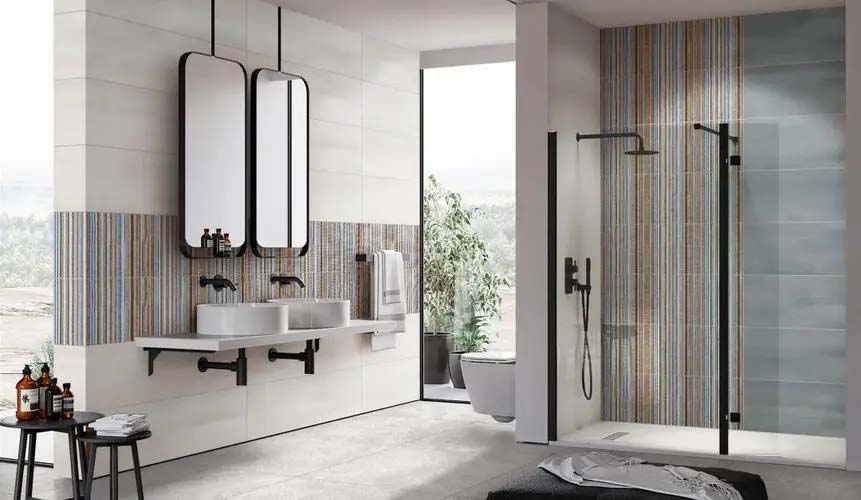Ceramic tiles have become increasingly popular for sustainable architecture and design projects. This is due to their durability, low cost, and aesthetic appeal.
This article will examine the advantages of using ceramic tiles for sustainable architecture and design. It will also discuss the types of ceramic tiles available, construction techniques for installation, cost considerations, and the environmental impact of using ceramic tiles.
Additionally, the article will explore how ceramic tiles can be used to create innovative and sustainable designs.
Overall, this article aims to provide a comprehensive overview of the use of ceramic tiles in sustainable architecture and design projects.

Various types of ceramic products exist, with each type providing a distinct aesthetic and functional purpose.
Glazed tiles are a popular type of ceramic tile, featuring a glossy finish.
Terracotta tiles offer a more rustic, traditional aesthetic, and are often used in outdoor settings.
While both glazed and terracotta tiles are attractive, they also provide important benefits for sustainable construction and design. The tiles are durable and require minimal maintenance, making them a great choice for green building projects. Additionally, they are highly efficient when it comes to energy consumption, providing insulation and reducing heating and cooling costs.
As such, ceramic tiles are an ideal choice for those looking for long-term sustainability.
With a range of options available, ceramic tiles can be used to create stunning designs that are both functional and efficient.
As such, ceramic tiles offer a great way to create a sustainable, aesthetically pleasing space.
With their combination of beauty and sustainability, ceramic tiles are an ideal choice for sustainable architecture and design.
Installation of ceramic tiles requires the use of specialized construction techniques in order to ensure efficient and safe placement. The type of tile selected plays a significant role in the installation process, and the chosen grouting method will depend on the tile type, size, and desired effect.
When installing ceramic tiles, the surface must be properly prepared and level to ensure a successful outcome. It is important to use the appropriate adhesive and grout to achieve a secure bond between the tiles and the surface. Additionally, a sealant should be applied after the installation is complete to protect against water damage and to extend the life of the tiles.
To ensure a successful installation, it is important to follow the manufacturer's instructions for the specific tile being used. By utilizing these specialized construction techniques, architects and designers can achieve desired results that are both aesthetically pleasing and practical. When applied correctly, ceramic tiles can provide a sustainable and long-lasting solution for any building or design project. With cost considerations, ceramic tiles can be an economical choice for many projects.

Cost is an important factor to consider when selecting materials for any building or design project. Ceramic tiles are often chosen for their affordability and wide range of design options. Additionally, when renewable sources are used in production and efficient waste management is employed, ceramic tiles can be cost-effective over time, making them a great option for sustainable architecture and design.
The use of ceramic tiles provides the opportunity to minimize costs while still achieving a high quality end product. Furthermore, ceramic tiles are an excellent option for those seeking to reduce their environmental impact. With careful consideration, ceramic tiles can provide a cost-effective and sustainable solution for any building or design project.
The production and use of ceramic tiles has a significant environmental impact that must be carefully considered. Manufacturers of ceramic tiles employ a wide range of energy-intensive processes in their production, from the firing of the raw materials to the final product. As such, ceramic tiles must be evaluated in terms of their overall energy efficiency and carbon footprint.
Additionally, ceramic tile production and installation can involve a significant amount of water, making water conservation an important factor when selecting a tile. To reduce the environmental impact of ceramic tiles, designers should consider alternative materials and processes that conserve energy and water. For example, locally sourced materials can reduce the energy used in transport, while the use of recycled materials can reduce the overall demand for raw materials.

Ceramic tiles typically demonstrate high levels of resistance and durability, enabling them to last for many years. Life cycle costs are minimized by their long-term lifespan, estimated to be between 20 and 40 years.
Ceramic tiles can contribute to green building certifications by providing eco-friendly materials and aiding in energy efficiency. Their durability and versatility make them a viable choice for a variety of design and architecture projects.
Yes, there are health and safety concerns related to ceramic tiles, such as airborne dust and chemical exposure. It is important to be aware of these risks to ensure a safe and healthy environment. Innovative approaches to mitigate these risks should be explored.
Ceramic tiles are an innovative solution for outdoor installation due to their low environmental impact. They are durable, aesthetically pleasing, and easy to maintain, making them an ideal choice for those seeking an innovative and sustainable solution.
Cleaning ceramic tiles requires regular wiping with a damp mop or cloth and the use of a mild detergent. Regular maintenance should include checking for any signs of wear and tear and addressing them promptly. Special techniques, such as sealing and resealing, may be necessary to ensure longevity.

Ceramic tiles offer a variety of benefits for sustainable architecture and design. They are durable, water-resistant, fire-resistant, and easy to maintain. Furthermore, they are available in a wide range of colors, shapes, sizes, and textures, allowing for a unique yet functional design.
Construction techniques for installation are simple and cost-effective, while their environmental footprint is minimal. With their significant advantages, ceramic tiles are an excellent choice for sustainable architecture and design projects.